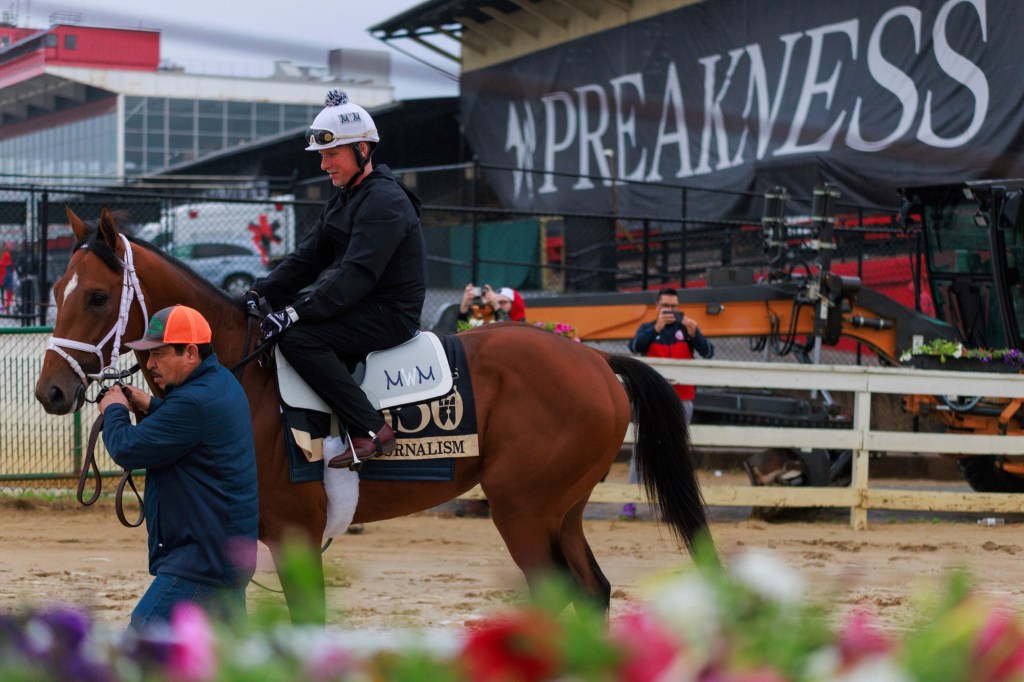
The 150th Preakness Stakes in Baltimore on Saturday shapes up as a 1 3/16-mile nostalgia tour.
Off the track, annual visitors to Pimlico Race Course will get their last glimpse of the old grandstand before its scheduled demolition and a new facility’s construction, a project that will push the Preakness to Laurel Park for at least its 2026 running.
On the track, Journalism has a good chance of dusting off an old Preakness plot line by using the race to restore order and get his 3-year-old championship campaign back on course after he was upset by Sovereignty in the Kentucky Derby.
Journalism, who was passed in the last 200 yards and finished second as a nearly 5-2 public choice in the Derby, is an 8-5 favorite on the morning line for the Preakness, leading a nine-horse field that includes 4-1 Sandman (seventh at Churchill Downs) and 15-1 American Promise (16th in Louisville).
A bounce-back victory for Journalism and jockey Umberto Rispoli would be nice for the Santa Anita Derby winner’s many fans in California – and good for the Preakness in these hard times.
A debate about the stature and future of the Triple Crown races caught fire again when Sovereignty’s trainer Bill Mott and owner Godolphin became the latest Kentucky Derby winners to opt not to run back in the Preakness two weeks later, and Journalism’s trainer Michael McCarthy and head owner Aron Wellman waited nine days to confirm they’d go.
One commentator suggested a radical idea. Mark Ratzky, the often-satiric racing writer and publicist and Southern California News Group handicapper, argued that the Kentucky Derby, Preakness and Belmont Stakes no longer are the three most important races for owners and would-be breeders of 3-year-old stars. Ratzky proposed in an email to a few dozen friends that a “New Triple Crown” would consist of the Derby in May, the Travers Stakes run at Saratoga in August and the Breeders’ Cup Classic for 3-year-olds and up to be run at Del Mar this November.
“Get to work on that,” Ratzky instructed Churchill Downs Incorporated, the New York Racing Association and the Breeders’ Cup, knowing full well that no such working together is to be expected on this or any other of the sport’s issues.
It got me working, though, researching how the prestige of various big races has risen and fallen across decades of changes in approaches to training and breeding.
Which stakes have become more common targets for the best 3-year-olds, and which have become less common? Which stakes are more likely to be seen as essential tests for the best of the age group, and which are less likely? Looking at the 40 years since the advent of the Breeders’ Cup reset the racing calendar, I charted which stakes were entered – and won – by horses who went on to be voted 3-year-old champions by media and executives. I’ll spare you the math. Here are the conclusions:
From 1984 to 1996 – the early Breeders’ Cup era – the Derby, Preakness and Belmont were dominant. The only race sending close to as many horses on to 3-year-old championship Eclipse Awards was the Florida Derby in March.
From 1997 to 2012 – the start of the Bob Baffert Era, for the dominant trainer of young thoroughbreds – the Derby and Preakness produced by far the most 3-year-old Eclipse winners. But the Belmont was getting a run for third in the pecking order from the Haskell Stakes held at Monmouth Park in July.
From 2013 to 2024 – the modern era, defined by the current Derby qualifying points system — the Derby has remained influential. But the Travers and Breeders’ Cup Classic have appeared to be the most important races for judging 3-year-old championship contenders. The Preakness and Belmont have been attracting fewer of the best horses than they used to.
So Ratzky is right about which three races to include if you were building the Triple Crown from scratch right now. (Since you’re wondering, the horse who has come closest to sweeping this New Triple Crown is American Pharoah, who won the Derby and Breeders’ Cup Classic and finished second to 16-1 Keen Ice in the Travers in 2015, the year he swept the Old Triple Crown.)
One surprising reminder, from looking back over the years, is that as recently as a decade go, the Preakness was central to 3-year-old championship hopes. From 1997 (Silver Charm) to 2015 (American Pharoah), 14 of 19 champion 3-year-old colts and geldings won the Preakness; two others finished second in the race, and another was champion 3-year-old filly Rachel Alexandra. In the 10 years between 2001 and 2010, four eventual champion 3-year-olds bounced back from defeats in the Derby to win the Preakness (Point Given, Afleet Alex, Curlin and Lookin at Lucky). The Derby was chaotic. The Preakness was definitive.
It would harken back to the Preakness’ days as a pivotal race if Journalism finds redemption Saturday. By handling the two-week Preakness turnaround while Sovereignty dodged it, the Santa Anita Derby winner could even return to the top of the class rankings despite leaving his Kentucky Derby defeat unavenged. Or maybe that’s old-fashioned thinking about the Preakness challenge – it has been 15 years since Eclipse Award voters crowned a 3-year-old who won the Preakness after not winning the Derby.
Journalism is the most accomplished horse in the Preakness, has been deemed in “grand” shape by his owners since losing the Derby by 1½ lengths, and has the tactical versatility to adjust to any pace. With rain in Baltimore probable Friday and possible Saturday, it’s good to know Journalism ran well on the sloppy track at Churchill Downs, but front-running Clever Again or Goal Oriented could benefit from a wet surface.
My picks: 1. Journalism, 2. Sandman, 3. Clever Again, 4. Goal Oriented.
Follow horse racing correspondent Kevin Modesti at X.com/KevinModesti.



